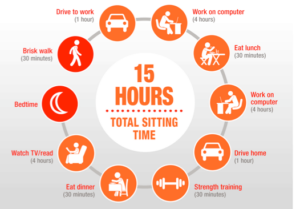The New Year is upon us with resolutions for a fresh start to 2018. Numerous people will be looking to improve their health, strengthen relationships, find better work-life balance, or just be happier. You’ll have a better shot at success if you set a goal that’s doable — and meaningful too. I have found that small changes are easier to accomplish and they can have a big influence when consistently performed. I will share a few simple ways to help you meet those health goals and more.
Bad News/Good News
Many people seek improved health and weight loss after the calorie-dense holidays. However, if you work an office job, chances are you spend most of your day sitting at your desk or in meetings. Add in sedentary time sitting for meals, driving in traffic, plus evenings spent binge-watching TV, and an overwhelming part of your day is inactive. The bad news is that science1,3 has linked inactivity with a worldwide meteoric rise of diabetes, heart disease, and other negative health issues. If you’re like most people, you don’t get much exercise and even if you are determined enough to carve out time in your busy schedule to exercise for 20-30 minutes a day, researchers2 warn your risk of heart disease and diabetes is still very high if you’re sedentary at work. It is good to exercise, but research is showing it is not enough given how sedentary our lives have become. The trend is so common they now have a name: Active Couch Potatoes. Most people are unaware the “goodness” of their exercise efforts is quickly undone by being inactive.
So what can you do if you happen to be someone like me who has struggled with this time crunch dilemma while seeking better health and happiness?
The good news is there are simple, effective lifestyle changes that yield positive health and performance gains. What if you could get the benefits of exercise plus better energy and increased performance during the day without the hassle of heading to the gym? The concept is called Wellness While Working and it involves adding a number of small movement changes and a few office equipment options to your daily routine that will quickly rack up big results. People are activating their workplace by adopting more sit-stand workstations, using movement oriented office accessories and just moving more throughout the workday. These small changes have been linked to decreased time spent sitting at work, and have also demonstrated positive effects on employees’ health and overall well-being.
Reason #1 – Move for Better Health – Low Intensity Movement Works Wonders
The human body was not designed to sit for prolonged periods of time and occupational obesity is a new threat to the American office worker. According to the National Institutes of Health, obesity is now the number two cause of preventable death in the United States, ranking behind smoking, and it may soon surpass smoking. In response, the American Medical Association (AMA) adopted policy H-440.843 Health Risks of Sitting recognizing the potential risks of prolonged sitting and encouraging employers, employees and others to make available alternatives to sitting. The AMA policy states, “Prolonged sitting, particularly in work settings, can cause health problems and offering employees alternatives to sitting all day will help create a healthier workforce.”
Looking for alternatives? Well don’t sweat it. Most people don’t realize that we don’t have to take on high intensity exercise to see big health benefits. Low intensity, ‘non-exercise’ physical movements like standing, walking or even using semi-standing/perching seats are simple but important ways to stay active. By being more active and just changing position, people can get a kick of energy, reduce the likelihood of back pain and improve their posture. More active work environments will increase blood flow, promote respiration, and studies4 have shown that alternating between sitting and standing positions throughout the burns more calories than sedentary sitting. The key point is to keep you body moving and avoid static sitting or prolonged standing. In fact, low-intensity “no-sweat” micro-movement activities such as fidgeting play a vital metabolic role. Using active devices while working like wobble chairs, perch/leaning seats, active footrests and stand-up balance boards can create a lot of movement and account for more of our daily energy expenditure than higher intensity activities. Who knew that rocking your day job could be so fun and beneficial to your health?
#2 – Move to be More Productive
Can all this moving around help me be more productive? According to a new study5 by Texas A&M University’s Health Science Center School of Public Health, it can. The study, which monitored 167 employees in a Texan call center over a six-month period, found that employees using stand-capable desks were more productive than their colleagues in standard, seated desks. And the productivity of the standing-desk workers continued to increase over their seated colleagues steadily over time. In the first month, the stand-capable group had 23 percent more successful calls than their seated colleagues, and by the sixth month, they had 53 percent more successful calls.
More recently in late December of 2017, The American Society of Interior Designers (ASID) completed a full spectrum of pre- and post-occupancy research on its new Washington, D.C. headquarters. The research shows how workplace design positively influences health, wellness, employee satisfaction, and work performance. ASID has seen increases in several productivity measures alluding to the impact of design on productivity. Absenteeism scores measured by how much employees are working more than expected by their employer, improved by 19 percent. Presenteeism, which is defined as workers present but not fully productive in the workplace, has also improved. ASID indicated that on average, employees feel they are working at 90 percent of their possible job performance, which is a 16 percent increase compared to their original office.
#3 – Move for Improved Collaboration and Engagement
Being more active has been associated with positive improvements in how a person feels and engages at work. Anecdotally speaking, my corporate office is fully equipped with height-adjustable desks and semi-standing seating, and it has made my post-lunch energy slump disappear. I feel that my voice sounds more confident while standing versus sitting so I especially like to use my standing desk during conference calls, delivering podcasts/webinars and while participating with colleagues during meetings.
My personal results are also now supported by published research6 from Washington University in St. Louis, MO. This study shows stand-up meetings support collaborative teamwork and more creative problem solving. Active meeting spaces increase in-group engagement and decrease in-group idea territoriality, thereby creating better information elaboration and better overall group performance. These exciting research findings demonstrate that the physical space in which a group works can alter how people think about their work and how they relate with one another.
Companies all over the world are realizing the benefits of more active meetings spaces. Recently, the high profile NYC venture capital firm FF Venture Capital found that standing meetings leads to more actively sharing ideas, which is why the firm outfitted its meeting rooms with standing conference tables. They noted that promoting movement in the workplace is a vital ingredient for collaboration. Their employees are more alert which may increase the likelihood of having an insightful conversation between colleagues. These types of positive interactions can help outweigh negative feelings about the workplace and improve overall happiness.
How Do I Get Started?
It all starts by deciding to get active, even in small ways, throughout the day. I believe that the best posture is your next posture, and that being too sedentary is bad for our health and our performance. High-performing organizations are increasingly adopting this notion and they understand that talented people are attracted to great workplaces that make it easy for their employees to add physical activity into each day.
Here’s a list of simple ways to activate your workday:
 Get up and out of your chair regularly after 20 minutes. Try using the 20-8-2 routines to alternate your posture that includes getting up after 20 minutes of sitting/perching followed by 8 minutes standing then 2 minutes of gentle moving or walking.
Get up and out of your chair regularly after 20 minutes. Try using the 20-8-2 routines to alternate your posture that includes getting up after 20 minutes of sitting/perching followed by 8 minutes standing then 2 minutes of gentle moving or walking.- Rather than emailing a colleague down the corridor, walk over and talk to them.
- Place different flavored coffee and nutrition options on different floors to encourage movement.
- Remove waste/recycling receptacles from the desk area and relocate to a centralized office location to promote movement.
- Consider hosting indoor or outdoor (weather permitting) walking meetings especially after lunch or anytime after eating to help lower blood sugar.
- Utilize Biophilia, our impulse to connect to nature, both indoors and outdoors, as it has been shown to increase work productivity by 15 percent, boost cognition and improve overall health7.
- Take the stairs whenever possible.
- Take public transit or park farther away from your office to add daily steps.
- Make more Active Seating options available in your office.
- Utilize dynamic or movement-oriented footrests while seated.
- Use standing desks supported with a complete accessory of solutions (anti-fatigue mat, footrail, balance board, semi-standing seat).
- The modern workforce is no longer static and creating a flexible design is a crucial element. Provide spaces that aren’t static. For example, workstations that convert into standing desks, movable walls, and areas that can quickly serve as meeting rooms and lounges.
- Finally, consider moving away from assigned cubicles and desks to more flexible team spaces with distinct neighborhoods. These agile designs support different types of work (focus, collaborative, training, social) and will help you to redesign the space as you expand, keep employee wellness front of mind and create privacy when it’s needed.
Remember that the worst thing you can do is to sit still or stand in a static position. Make the move to activate your day with simple and small effective changes and celebrate your achievements, no matter how small.

References
- Mathers, C., Stevens, G., & Mascarenhas, M. (2009). Mortality and burden of disease attributable to selected major risks. World Health Organization. Retrieved from http://www.who.int/healthinfo/global_burden_disease/GlobalHealthRisks_report_full.pdf
- Matthews, C. E., et al. (2015). Mortality Benefits for Replacing Sitting Time with Different Physical Activities. Medicine & Science in Sports & Exercise, 47.9, 1833-40. Retrieved from National Center for Biotechnology Information https://www.ncbi.nlm.nih.gov/pubmed/25628179
- van der Berg, J., et al. (2016). Associations of total amount and patterns of sedentary behavior with type 2 diabetes and the metabolic syndrome: The Maastricht Study. SpringerLink, 59.4, 709-718. Retrieved from http://link.springer.com/article/10.1007/s00125-015-3861-8
- http://www.livestrong.com/article/73916-calories-burned-standing-vs.-sitting/
- Garrett, G., Benden, M., Mehta, R., Pickens, A., Peres, S. C., & Zhao, H. (2016). Call Center Productivity Over 6 Months Following a Standing www.juststand.org 3 Desk Intervention. IIE Transactions on Occupational Ergonomics and Human Factors, 4.2-3, 188-195. Retrieved from http://www.tandfonline.com/doi/abs/10.1080/21577323.2016.1183534?tokenDomain=eprints&tokenAccess=km4nB428SqEGEqw7Bwjz&forwardService=showFullText&doi=10.1080%2F21577323.2016.1183534&doi=10.1080%2F21577323.2016.1183534&journalCode=uehf20.
- Knight, Andrew & Baer, Markus. (2014). Get Up, Stand Up: The Effects of a Non-Sedentary Workspace on Information Elaboration and Group Performance. Social Psychological and Personality Science. 5. 910-917. 10.1177/1948550614538463.
- Nieuwenhuis, M., Knight, C., Postmes, T., & Haslam, S. A. (2014). The relative benefits of green versus lean office space: Three field experiments. Journal of Experimental Psychology: Applied, 20(3), 199-214.
Connect with the author

Josh is a Certified Professional Ergonomist with over 30 years of experience working in corporate, educational, manufacturing and medical settings. His background includes developing well-being initiatives, supporting injury prevention programs, and creating product designs to improve human performance. He has written and presented worldwide on topics of health, wellness, product design and personal development for blogs, conferences and for national publications.
Josh Kerst CPE, CIE
Principal Ergonomist | c 734-707-3808
9300 West Research Center Rd | Minneapolis, MN 55428
facebook | pinterest | twitter | youtube | LinkedIn
